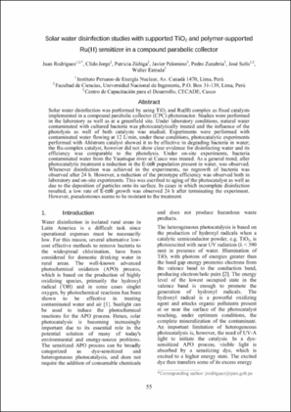Mostrar el registro sencillo del ítem
Solar water disinfection studies with supported TiO2 and polymer-supported Ru(II) sensitizer in a compound parabolic collector
| dc.contributor.author | Rodríguez, Juan | |
| dc.contributor.author | Jorge, Clido | |
| dc.contributor.author | Zúñiga, Patricia | |
| dc.contributor.author | Palomino, Javier | |
| dc.contributor.author | Zanabria, Pedro | |
| dc.contributor.author | Solís, José | |
| dc.contributor.author | Estrada, Walter | |
| dc.creator | Zanabria, Pedro | |
| dc.creator | Estrada, Walter | |
| dc.creator | Solís, José | |
| dc.creator | Rodríguez, Juan | |
| dc.creator | Palomino, Javier | |
| dc.creator | Zúñiga, Patricia | |
| dc.creator | Jorge, Clido | |
| dc.date.accessioned | 2016-01-13T16:42:19Z | |
| dc.date.available | 2016-01-13T16:42:19Z | |
| dc.date.issued | 2008-11 | |
| dc.identifier.citation | Rodríguez J, Jorge C, Zúñiga P, et al. Solar water disinfection studies with supported TiO2 and polymer-supported Ru(II) sensitizer in a compound parabolic collector. Informe Científico Tecnológico. Volumen 7 (2007) p. 55-62. | es_PE |
| dc.identifier.issn | 1684-1662 | |
| dc.identifier.uri | https://hdl.handle.net/20.500.13054/535 | |
| dc.description.abstract | Solar water disinfection was performed by using TiO2 and Ru(II) complex as fixed catalysts implemented in a compound parabolic collector (CPC) photoreactor. Studies were performed in the laboratory as well as at a greenfield site. Under laboratory conditions, natural water contaminated with cultured bacteria was photocatalytically treated and the influence of the photolysis as well of both catalysts was studied. Experiments were performed with contaminated water flowing at 12 L/min, under these conditions, photocatalytic experiments performed with Ahlstrom catalyst showed it to be effective in degrading bacteria in water; the Ru-complex catalyst, however did not show clear evidence for disinfecting water and its efficiency was comparable to the photolysis. Under on-site experiments, bacteria contaminated water from the Yaurisque river at Cusco was treated. As a general trend, after photocatalytic treatment a reduction in the E-coli population present in water, was observed. Whenever disinfection was achieved in the experiments, no regrowth of bacteria was observed after 24 h. However, a reduction of the prototype efficiency was observed both in laboratory and on-site experiments. This was ascribed to aging of the photocatalyst as well as due to the deposition of particles onto its surface. In cases in which incomplete disinfection resulted, a low rate of E-coli growth was observed 24 h after terminating the experiment. However, pseudomones seems to be resistant to the treatment. | es_PE |
| dc.description.sponsorship | SOLWATER Project ICA4-CT-2002-10001 - International Science Programme of Uppsala University, Sweden | |
| dc.format | application/pdf | es_PE |
| dc.language.iso | eng | es_PE |
| dc.publisher | Lima (Perú) | es_PE |
| dc.rights | info:eu-repo/semantics/openAccess | es_PE |
| dc.source | Instituto Peruano de Energía Nuclear | es_PE |
| dc.source | Repositorio Institucional del Instituto Peruano de Energía Nuclear | es_PE |
| dc.subject | Energía solar | es_PE |
| dc.subject | Óxidos de titanio | es_PE |
| dc.subject | Agua | es_PE |
| dc.subject | Desinfección | es_PE |
| dc.title | Solar water disinfection studies with supported TiO2 and polymer-supported Ru(II) sensitizer in a compound parabolic collector | es_PE |
| dc.type | info:eu-repo/semantics/article | es_PE |
| dc.publisher.country | PE | es_PE |





